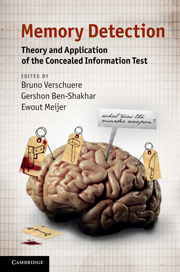Book contents
- Frontmatter
- Contents
- List of figures
- List of tables
- Notes on contributors
- Acknowledgments
- Part I Introduction
- Part II The laboratory: theoretical and empirical foundations of the Concealed Information Test
- Part III Field applications of concealed information detection: promises and perils
- 8 Limitations of the Concealed Information Test in criminal cases
- 9 Validity of the Concealed Information Test in realistic contexts
- 10 Leakage of information to innocent suspects
- 11 Countermeasures
- 12 Psychopathy and the detection of concealed information
- 13 Clinical applications of the Concealed Information Test
- 14 Daily application of the Concealed Information Test: Japan
- 15 The Concealed Information Test in the courtroom: legal aspects
- Part IV Conclusions
- Index
- References
10 - Leakage of information to innocent suspects
Published online by Cambridge University Press: 05 June 2012
- Frontmatter
- Contents
- List of figures
- List of tables
- Notes on contributors
- Acknowledgments
- Part I Introduction
- Part II The laboratory: theoretical and empirical foundations of the Concealed Information Test
- Part III Field applications of concealed information detection: promises and perils
- 8 Limitations of the Concealed Information Test in criminal cases
- 9 Validity of the Concealed Information Test in realistic contexts
- 10 Leakage of information to innocent suspects
- 11 Countermeasures
- 12 Psychopathy and the detection of concealed information
- 13 Clinical applications of the Concealed Information Test
- 14 Daily application of the Concealed Information Test: Japan
- 15 The Concealed Information Test in the courtroom: legal aspects
- Part IV Conclusions
- Index
- References
Summary
Overview: A key assumption of the CIT is that the relevant information is known by guilty suspects but not by innocent suspects. Leakage of the relevant information to innocent suspects thereby presents a conundrum for those involved with the development and administration of tests designed to discover concealed information. Leakage is potentially important as it may not be possible to discriminate responding by innocent and guilty suspects to leaked information. This would result in erroneous classification of the innocent suspects. This chapter examines theory and empirical results to better understand: (1) the issues involved in leakage; (2) to ascertain whether situations involving leakage can contribute to a better understanding of information detection; and (3) to explore possible ways of either managing or preventing leakage so that it does not contaminate information detection situations.
The nature of CITs
Behavioral, physiological, emotional, and cognitive reactions to items of information can be used to associate individuals with specific knowledge. A great deal of attention has been paid to make use of these reactions to discover who has knowledge of issues under investigation. In the investigatory and criminal realm, knowledgeable people, however, typically attempt to conceal their knowledge. Unfortunately, most people, including those who routinely engage in deception detection, are not very accurate in discerning if there is hidden information (Bond and DePaulo, 2006; Sato and Nihie, 2009). Physiologically the situation is different: the reactions are less readily under conscious control. They are not necessarily simple but have been well studied and described.
- Type
- Chapter
- Information
- Memory DetectionTheory and Application of the Concealed Information Test, pp. 187 - 199Publisher: Cambridge University PressPrint publication year: 2011
References
- 10
- Cited by



